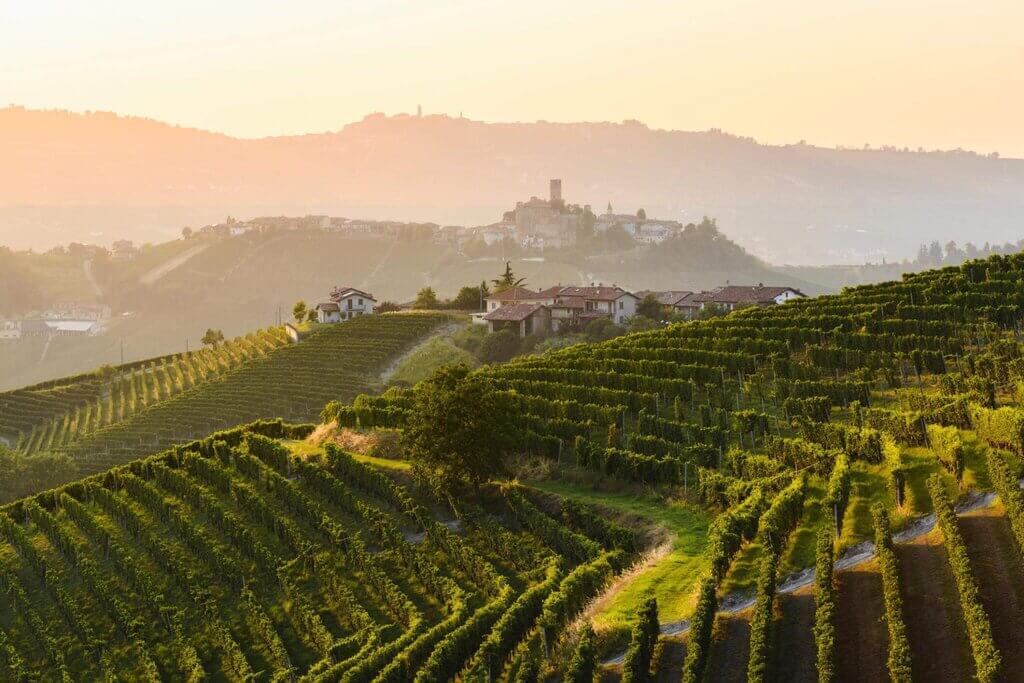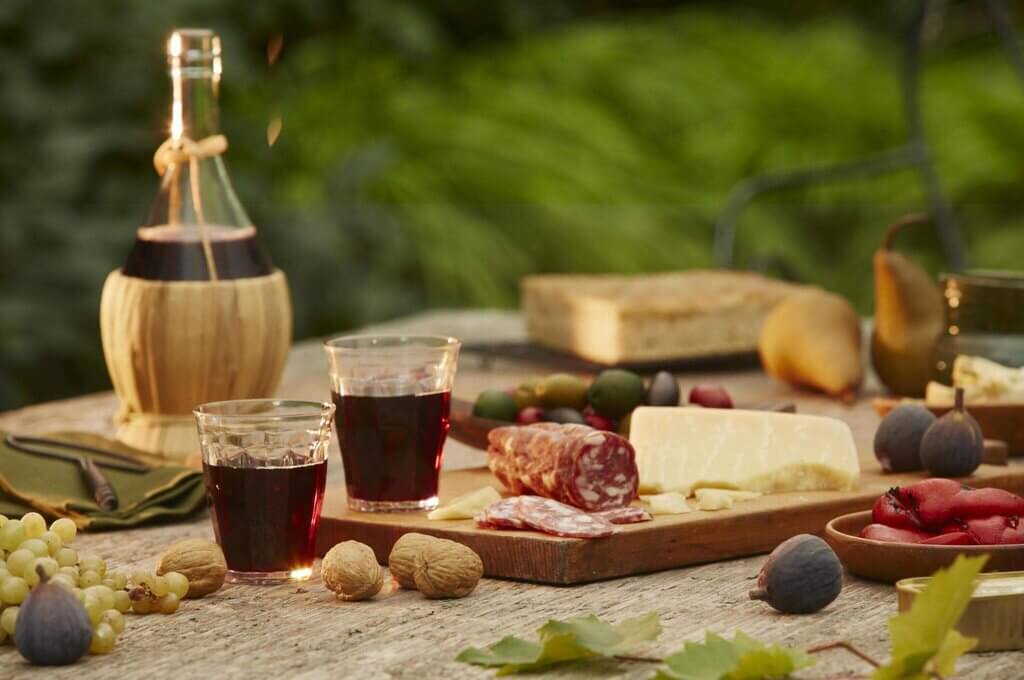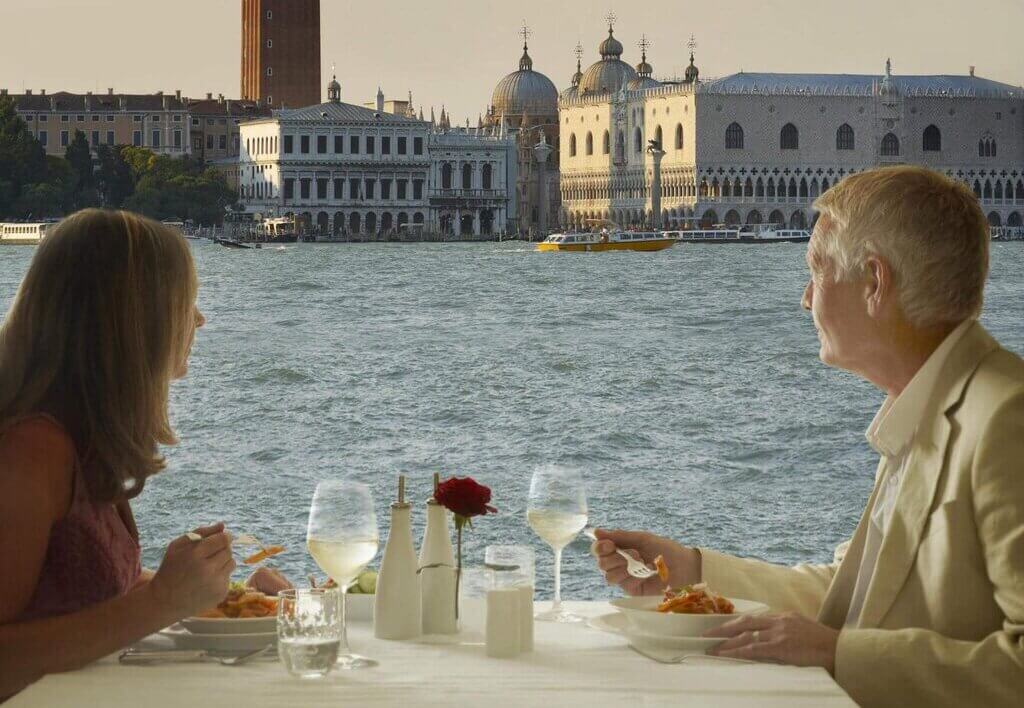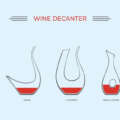Italian wines used to seem so complicated to me when I first started working at the wine bar. With so many grapes, regions and classifications to make sense of, I felt lost trying to understand it all. But after 5 years now of serving Italian wines to customers every night, I’ve broken things down into simple, easy-to-grasp parts.
Italian Wines Classifications
Let’s start by clearing up some confusion around Italian wine classifications. Rather than grading the wine’s overall quality like some countries do, Italy focuses on 2 main things:
- Where the grapes are grown
- How the wine is made
Simple as that! Now let me decode those Italian laws and labeling terms…
What is DOC and DOCG?
These are designations you’ll see on many Italian wine labels.
DOC stands for Denominazione di Origine Controllata. This means wines made under strict regulations in designated regions using approved grape varieties and winemaking methods. For example, for a wine to be classified as Chianti Classico DOC, it must contain 80-100% Sangiovese grapes and come from the Chianti area of Tuscany.
DOCG is a higher ranked classification called Denominazione di Origine Controllata e Garantita (“controlled and guaranteed”). It follows even stricter production rules and the wines have been through official taste tests. Like Brunello di Montalcino DOCG must contain 100% Sangiovese Grosso grapes from the Montalcino area.
So when you see either DOC or DOCG on a label, you can expect wine made according to quality standards for that region.
IGT
Another designation is IGT which stands for Indicazione Geografica Tipica (typical geographical indication). These wines can offer more flexibility on grape blends and winemaking methods rather than following DOC or DOCG constraints. But IGT still means the grapes come from the designated place on the label. So the location aspect is key here even if the wine itself is more experimental style. Many modern “Super Tuscans” fall under the IGT category.
VdT / Table Wine
You might also come across VdT on labels, which is short for Vino da Tavola. This equates to basic ‘table wine’ without needing to follow appellation laws. Quality can vary quite a bit. But in general these are affordable, easy drinking wines to have with weeknight meals.
I know even these 4 main Italian wine designations can seem like a lot to digest! But just remember the 2 factors they address—where the grapes come from and how it’s made based on those region’s traditions. The label terms simply give insight into those things.
Now Over to Italian Wine Labels!
With the classifications explained, let’s shift to decoding Italian wine labels themselves:
Unlike American wines that highlight the grape varietal upfront, most Italian wine labels place more emphasis on location. But don’t panic! Here are 3 tips to guide you:
- The location will tell you where the wine’s from. This usually drills down to the specific town or village rather than a broad region. Recognizing key regions can help piece the puzzle together.
- The producer name indicates the winery/company making the wine. Getting familiar with different producers helps you determine the wine’s general quality and style.
- The designation provides rules on how the wine was made based on that area’s winemaking traditions. So you can expect a Chianti Classico DOCG to contain mostly Sangiovese grapes while a Primitivo DOC wine contains the Zinfandel grape.
It just takes some getting used to this location-first approach! But soon you’ll get the hang of pinpointing Italian wine details from the label.

Now Let’s Highlight Italian Wine Regions and Grapes
With the laws and labels decoded, let’s journey into Italy’s prime wine production regions and the famous italian varieties:
Tuscany with Its King Sangiovese Grape
First we head to the rolling hills of Tuscany, perhaps Italy’s most famous wine zone. Known for big, bold reds, the king grape here is Sangiovese. Its flavors of tart cherries, strawberry and herbs match brilliantly with tomato sauces and grilled meats. Chianti Classico DOCG and Brunello di Montalcino DOCG rank among Italy’s highest quality Sangiovese-based wines, while Vino Nobile di Montepulciano DOC offers great value. Beyond the reds, crisp white Vernaccia di San Gimignano DOC joins my seafood pasta perfectly with lemon and toasted almond notes.
Piedmont – Land of Truffles and Long-Lived Reds
Traveling northwest, we come to the Piedmont area nestled against the Alps. Blanketed in fog, this hilly terrain specializes in big, structured reds that age gracefully thanks to abundant natural acidity. Made from the late-ripening Nebbiolo grape, Barolo and Barbaresco represent Italy’s highest wine pedigree and can demand over $100 per bottle when made well! At its best after 10-30 years aging, Nebbiolo reveals delicate flavors of rose, cherry, tobacco and truffles. For a more everyday red, try Barbera with its juicy cherry vibrancy and tangy acidity that cuts through rich sauces and meat dishes.
Bubbly Proseccos from the Veneto
If we keep heading east, we run right into the Veneto hills near Venice. This is where world-famous Prosecco sparkling wines hail from! Made primarily from Glera grapes, Prosecco brings joyful flavors of white peach, lemon zest and honeysuckle in a frothy sip. Crisp and dry yet friendly flavors make it super food-friendly. Because Prosecco uses the tank method rather than second fermentation in bottle like Champagne, you get those pleasant flavors at a nicer price-point too! Around 10 million glasses get popped daily!
Campania’s Coastal Whites and Plucky Reds
Venturing down the boot near Naples, volcanic soil and cooling coastal breezes bless Campania with excellent whites and distinctive reds. One stand-out is Fiano di Avellino DOCG showing creamy texture and aromas of toasted nut and fresh pear that pair nicely with seafood. The reds here lean towards full-bodied with concentrated flavors. Made primarily from the grapes Aglianico and Piedirosso, I suggest braising beef ragù or meatballs to accompany these more robust reds. With such diversity, Campania wines can satisfy both white and red drinkers!
Let’s stop the tour here, as we’ve already covered so much ground! We only scratched the surface of Italy’s 20 unique wine regions and hundreds of grape varieties. But by breaking down the basics around laws, regions and labels, you hopefully feel better oriented to explore. And exploring different wines is key to discovering new favorites! Don’t be afraid to try—no previous wine expertise required! Just have fun choosing an interesting bottle, use my decoding tips to make sense of the label, then enjoy Italian wine culture one tasty sip at a time. Salute!

Choosing, Serving and Pairing Italian Wines
To wrap up, I’ll leave you with quick tips for choosing, serving and pairing Italian wines once you’ve made your selection:
*Italian red wine or Italian white wine? More casual weeknight pasta, pizza and tomato-sauce dishes call for fruity red wines like Chianti Classico or Valpolicella. While brighter seafood, salads and veggies pair nicely with a tangy Pinot Grigio or lemony Falanghina white.
*Unsure of what to try? Browse shop shelves or wine lists by the region instead of grape to discover new areas. Or ask wine merchants for an off-the-beaten-path suggestion! The next great producer is out there waiting to be found.
*How’s the price range? More basic Italian table wines and DOC classics like Montepulciano d’Abruzzo offer bang-for-buck for everyday enjoyment. While DOCG wines from Barolo and Brunello zones represent Italy’s top pedigree for celebrations and gifts.
*What’s the vintage? Italy’s sunny climate means most young wines are ready to sip soon after harvest. So focus on recent vintages for the freshest flavors. But certain wines like Barolo, Brunello and Amarone improve with age so check year and cellaring guidance.
*Glass or bottle? By-the-glass gives greater variety to taste different Italian wine styles when dining out. Then order your favorite by the bottle! Non-vintage Proseccos let you sample bubbly too without the sticker shock.
*What to eat with it? Italian wines lend so many food pairing ideas—too many to list
Food Pairing Italian Wines
Matching Italian wines with foods can seem tricky until you remember a few key tips:
- Bright, high-acid reds love tomato sauce, so Chianti and Montepulciano make perfect partners for pizza and pasta. Their tart cherry and herbal flavors cut through cheesy richness too.
- Elegant reds loaded with tannins and earthy flavor, like Barolo and Brunello, complement slow-cooked meat ragus, osso buco stew, and wild game that can stand up to their structure.
- Light, citrusy whites like Pinot Grigio, Vermentino and Falanghina refresh simply prepared seafood, salads, and herbed chicken or fish. The citrus and floral tones dance with the fresh ingredients.
- Fuller-bodied dry whites like Chardonnay and Fiano bring nice weight alongside cream or oil-based dishes. The creamy peach and honey notes match the texture and flavors.
- Sparkling Prosecco isn’t just for celebrating! Its crisp green apple and pear flavors refresh before dinner or alongside bean dishes and light appetizers throughout the meal.
See, Italian wines can complement such a range. Many are expressly made to be enjoyed with food versus analyzed on their own. My rule is what grows together goes together. Like Sangiovese and the Tuscan cuisine the grape is intertwined with.
Gifting Italian Wines
With their history and tradition, Italian wines also make excellent gifts for wine loving friends or clients. Some suggestions:
- Chianti Classico Reserva for the red wine fan – Choose a reputable Chianti producer like Castello di Volpaia or Rocca delle Macìe for smooth enjoyable drinking. The iconic black rooster seal says Tuscan soul!
- Prosecco for bubbly lovers – Pick a single vineyard Cartizze Prosecco with elegant small bubbles or splash out for a vintage Franciacorta, Italy’s Champagne rival. Luxe packaging ups the wow factor!
- Barolo or Barbaresco for special occasions – Seek top estates like Giacomo Conterno or Gaja for collectable reds they’ll treasure. Even younger vintages of these evolving wines guarantee enjoyment.
- Mix regional gift packs – Combine breezy Vermentino white from Sardinia or Sicily along with a rich Nero d’Avola or Primitivo red for fun discovery. Include salami and olives to make the experience even more authentic! Personalize with custom labels commemorating the occasion.
With so many amazing wine options, choosing the perfect Italian bottles as gifts is actually the tough part! But it shows how much passion and storytelling go into Italian wines—they always make for memorable presents.
Learning Italian Wine Culture
I hope this beginner’s guide gets you excited to further explore the world of Italian wines! Here are a few final tips on delving deeper into understanding Italian wine culture:
- When visiting wine shops or restaurants’ lists, browse by region to spot patterns of grapes/styles from different zones. Comparing a big Barolo to an elegant Pinot Grigio really emphasizes the diversity.
- Study maps showing Italy’s hundreds of native grapes by region. Few countries can match this level of terroir expression. See which lesser known grapes intrigue you to try.
- Read up on influential winemakers who shaped Italy’s wine renaissance. The famed “Super Tuscan” creators brought modern winemaking back to a country resting on old laurels. See what motivated them.
- Watch video vineyard tours and interviews with producers to glimpse the generations of family dedication behind many Italian wines. You feel transported to Italy listening to their stories!
- Book a trip to your favorite Italian wine zones when possible to visit in person. Nothing moves you more than walking the ancient vines in Tuscany’s Chianti hills or watching Piedmont’s gentle fog creep over Nebbiolo vineyards. The wines come alive!
Is Italian wine the Ultimate Champion?
Not so fast! Whether it’s “better” depends on your tastebuds and what you’re craving. Here’s the lowdown:
Italy’s got game:
- Variety galore: From light, crispy whites to bold, brooding reds, Italy offers a whole smorgasbord of styles and grape varieties. Think juicy Primitivo bursting with plums, or Chianti, that Tuscan cherry dream.
- Quality counts: Italians take their vino seriously, focusing on traditional methods and top-notch grapes. Every sip speaks of dedication, depth, and character.
- Food friends: Italian wines and their country’s food scene are besties. Imagine Chianti tangoing with a hearty pasta, or Pinot Grigio serenading a seafood salad. Perfection!
- Culture in every sip: Wine is woven into the fabric of Italian life, adding a layer of history and joy to every glass. It’s about sharing, laughing, and savoring the good life.
But hey, there’s another side of the story:
- Taste is king: Some folks might prefer the punchy Aussie Shiraz or the elegance of a French Pinot Noir. It’s all about your personal flavor map, after all.
- Price matters: Some Italian wines can carry a hefty price tag, especially the esteemed ones. There are budget-friendly gems from other regions, too.
- Finding your fix: Depending on where you live, Italian wines might be harder to track down than options from closer to home.
So, instead of crowning a champion, why not embark on a vino adventure? Explore Italian grape varieties, discover hidden gems, and find the wines that make your tastebuds sing. Remember, “better” is all about what delights you! Cheers to that!
Italian Wine FAQs: Your Easy A-Z Guide
Italy, sun-soaked cradle of grape and olive, has a reputation for world-class vino. Yet, navigating its diverse regions, names, and traditions can feel like cracking Da Vinci’s code. Fear not, wine explorers! This FAQ uncorks the Italian wine mysteries:
What’s Italy’s top sip?
No winner-winner chicken dinner here! Chianti, the Tuscan cherry bomb, is a big hit. Prosecco, the bubbly delight from Veneto, pops off at parties. Then you’ve got Barolo, a powerful red from Piedmont, fancy enough for kings. And don’t forget Primitivo, the southern star bursting with juicy plums.
What do they call all this wine?
Think of it like secret codes! “Vino” simply means “wine.” DOCG is the top dog, guaranteeing the wine comes from a specific place and is super high-quality. DOC is like DOCG’s little brother, still with rules about where the grapes come from. IGT is more relaxed, just saying the wine comes from a certain area. And sometimes, the wine’s just named after the grape, like Sangiovese or Primitivo. Easy peasy!
What do Italians actually drink?
They love their local heroes! Each region has its own style, and Italians happily sip what grows around them. For everyday meals, they reach for light, easy-drinking wines like Prosecco and Pinot Grigio. When food’s on the table, Sangiovese reds like Chianti are the perfect partners. And let’s not forget the bubbly – Prosecco is the life of the party and a yummy pre-dinner treat.
Why’s Italian wine so famous?
It’s like a delicious history lesson in every glass! Winemaking goes back centuries in Italy, and they take it seriously. They care about where the grapes come from, how they’re grown, and how they’re turned into wine. This dedication to quality shines through in every sip, from crisp whites to bold reds. And don’t forget the food – Italian wine and Italian food are like best friends, making every meal a masterpiece.
Do most Italians drink wine?
It’s like part of their daily routine! Most adults enjoy it regularly, but in a chill, responsible way. It’s about sharing, laughing, and savoring the good life, not chugging bottles.
Is Italy a wine giant?
You bet! They’re one of the biggest producers and exporters in the world, their diverse wines conquering palates everywhere. From the rolling hills of Tuscany to the sunny shores of Sicily, Italy’s a treasure trove for wine lovers. Add the amazing food and culture, and you’ve got the ultimate wine adventure waiting!
I sincerely hope this guide brought the passion, diversity and culture of Italian wines to life. By breaking down the main laws, grapes and regions, understanding Italian wine doesn’t need to seem intimidating anymore. Now’s the time to start your own journey of discovery! Please let me know if any other questions come up. Salute!



